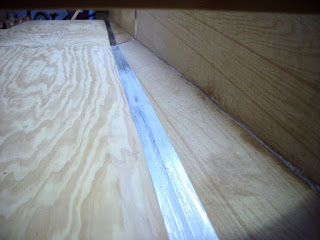Back to report the latest progress on the trailer.
The trailer is back from being in storage at the Sandia Trailer. I was finally able to afford to pay the balance and bring it home to work on "Phase IV"
They did a great job installing the side skins and new floor.
And the jinx is still with the trailer.... when I was pulling the trailer out of storage yard, the turn was tight, and my tailgate was down at the time, holding the wood that was used as a cover, so, the gate tore into the skin on the front of the trailer!... Shit!
Before I can build the first mold, I needed to make room in the garage. Since I had no place to store the wings, I had to cocoon them in plastic, and store them outside. (I hated to do it, but it was my only only option.
I purchase the wood for the mold frame last year, while I still had money. The design of the molds will allow me to dis-assemble them from around the fiberglass cast. The first part of the mold was the top of the trailer. This also became the base.
Using the plans that I drew up, I created the side frames using 2x4's and cover the inside of the mold with wall paneling.
The next step was tricky. Since the top was made with two sheets of finished plywood, which where 4'x8' in size, the width of the top was two inches too narrow. the base width of the trailer sides needed to be just over 4' 1" to mate with the lower frame on the trailer top. I added scraps of wood to bring the base mount out to accommodate the attachment of the side panels.
Once the sides were up, the main box mold was finished, now I needed to devise a way to close off the open slit that runs the full length of the mold were the sides align with the base top, then the end cap.
I found that the cheap wall paneling was easy to cut, and I came up with a way to create a bevel top edge.
I secured the panel material with a hot glue gun and aluminum duct tape.
The end cap was simple to make. I just used a strip of the paneling and then taped it up.
With the mold finished, I'm ready to seal the wood and paneling matrial with a fiberglass mold release agent.
This mold is 16' long. and is almost 2/3rds of the length of the trailer.
To prevent the fiberglass resin sticking to the material I used release wax and a solution of PVA. After the PVA dried, I dropped in a layer of peel ply nylon.
The nylon was attached using masking tape and staples.
The first layer applied was the 10oz cloth.
Followed by the 6oz fiberlass mat. Mat is the biggest pain in the ass to use. The only plus side it, it adds bulk quickly, and adds greater strength. The down side is, fibers get everywhere, and it soaks up a lot of resin!... Gallons of it!
This concludes the first stage of the fiberglass top. This will cover the back 2/3rds of the trailer.
The last layer was an 18oz fiberglass roving. After the resin cured fully, I started to lay in the internal support structure. The material that was recommened for this purpose, was cardboard tubing. The tubes were cut in half, and the taped in place.

After the tubes were taped in, I was ready to fiberglass them in place. I used two layers of fiber glass tape.

The resin soaked into the cardboard, making it extra ridged.
After the tube supports were glassed in, I was ready to pop the mold off. The sides for the most part seperated with little effort. There was only a couple of areas that the resin adhered to the paneling material.
I used wooded shims to pop the glass cast from the bottom plywood base.

The verical fin cover was made from a male mold, made of foam.
I covered the mold with aluminum tape and then waxed the mold with release wax.
The same number of layers of fiberglass was applied to the mold as match the trailer top.
The trailer shell was rotated right-side-up and stabilized with saw horses.
The fincap was then mounted to the top and fiberglassed in place. Both, on the outside, and then inside.
The skin was fairly smooth, but are areas that needed attention.
Primer was used to find the areas that needed to be filled.
The fin cap required more work, since it was popped off a male mold. The resin voids and pits holes needed to be filled and sanded.
While this work was going on, and moving the top around, I had to add addition glass strips to the tube supports, since I noticed some areas that were stressed.
I relalized that I would need some additional steel loops in the trailer top to support the area were the two parts would be mated together, and also the front area for the access hatch.
Making the forward section will be a challange, now that the temperature is in the 80's here. I will be casting in the early hours before sunrise, or in the late evening, when it starts to cool down.
Before I can make that front portion, I will need to make room in the garage, and that means mounting the back half to the trailer.









































































